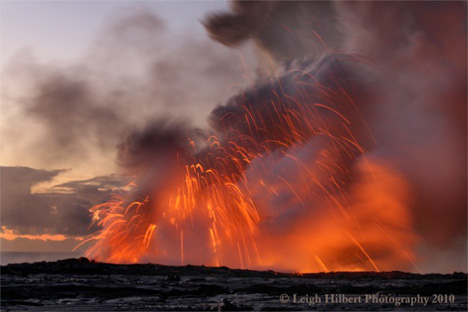In the process of researching captions I can run into some amazing stuff, like this photo (taken yesterday) of incandescent rocks arcing through the sky during the collapse of a lava bench near Kilauea:

The USGS explains: “lava can instantly transform seawater to steam, causing explosions that blasts hot rocks, water, and molten lava fragments into the air.” No kidding.
Leigh’s site, Hawaiian Lava Daily, has some of the best photos of Hawaii’s active lava flows I’ve ever seen. He also pointed me to this description and photo essay of the last moments of Gary Sleik’s house in Kapana Gardens—destroyed by lava in July—as well as a recent “wake” for the house. An intimate look at events that can appear quite impersonal from space.




This photo is amazing! Thanks for the link. Your whole site is wonderful. Always. Thanks so much for your work.
Thank you for this site! It helps me keep life and its constant bumps and blips in perspective with the big picture! The photos are always amazing. Thanks for sharing!
Thanks for the link to Gary Sleik’s house and wake photos. So often, just the really interesting lava shot makes the front page – the human elements are often left off.
Interesting that I came to this post directly from the global warming blog on this site. What government agency would be responsible for connecting the dots between recent volcanic activity and climate change? Is that something NASA is responsible for or would another agency be able to provide any information?
James: NASA does some work on the link between volcanoes and climate change, we even have a story about it: Volcanoes & Climate Change. In essence big volcanic eruptions slightly cool the climate, but only for a few years. If the right type of volcanic emissions gets into the stratosphere they reflect sunlight back into space before it gets absorbed by the surface and turns into heat. Volcanoes emit some carbon dioxide, but it’s only about 1% of current human emissions, and the amount is steady over time (volcanoes were emitting carbon dioxide before humans started burning fossil fuels—and will continue after we stop), while humans emit more every year.
Amazing. An ultra zoom lens was probably used here. If I am in here taking this photo, I can afford to go 100 meters away from that crater. yikes..